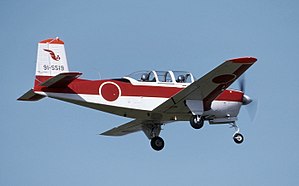Fuji T-3
| T-3 | |
|---|---|

| |
| Fuji T-3 | |
| Role | Primary trainer |
| Manufacturer | Fuji Heavy Industries |
| First flight | 1978 |
| Primary user | Japan Air Self Defense Force |
| Number built | 50 |
| Developed from | Fuji KM-2 |
The Fuji T-3 is a primary military trainer aircraft used by the Japan Air Self Defense Force, manufactured by Fuji Heavy Industries. Its first flight was in 1978. In the course of its service life, 50 units were produced. It is being replaced by the Fuji T-7.
Development
The KM-2B was a further development of the Fuji KM-2 (itself a four-seat development of the T-34 Mentor with a more powerful engine) for use as a primary trainer for the Japan Air Self-Defense Force (JASDF). It combined the structure and engine of the KM-2 with the tandem cockpit of the T-34 Mentor. Its first flight was on 17 January 1978.[1] Fifty were purchased by the JASDF as the Fuji T-3, and production continued until 1982.[2]
Operational history
The Fuji T-3 served with the 11 and 12 Hiko Kyoikudan (flying training wings) of the JASDF. It is currently being replaced with the Fuji T-7, a turboprop variant of the T-3 [3] with a 400 shp (300 kW) Allison 250 engine.
Operators
Specifications (T-3)
Data from Jane's Aircraft Recognition Guide, Jane's All the World's Aircraft, 1976-1977 [4][5]
General characteristics
- Crew: 2: student, instructor
Performance
See also
Related development
Related lists
References
- ^ Donald, David; Lake, Jon, eds. (1996). Encyclopedia of World Military Aircraft. London: Aerospace Publishing. ISBN 1-874023-95-6.
- ^ Donald, David, ed. (1997). The Encyclopedia of World Aircraft. London: Aerospace Publishing. ISBN 1-85605-375-X.
- ^ Taylor, M J H, ed. (1999). Brassey's World Aircraft & Systems Directory 1999/2000 Edition. London: Brassey's. ISBN 1-85753-245-7.
- ^ Rendall, David (1995). Jane's Aircraft Recognition Guide. Glasgow, UK: HarperCollinsPublishers. p. 505. ISBN 0-00-470980-2.
- ^ Taylor, JWR, ed. (1976). Jane's All the World's Aircraft, 1976-1977. London: Macdonald and Jane's. ISBN 0-354-00538-3.
